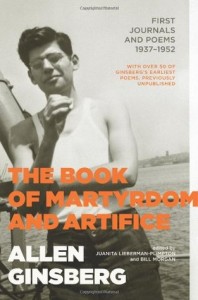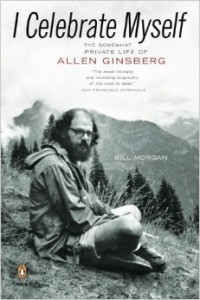 The Book of Martyrdom and Artifice: First Journals and Poems, 1937-1952
The Book of Martyrdom and Artifice: First Journals and Poems, 1937-1952
by Allen Ginsberg
DaCapo Press. 523 pages, $27.50
 Collected Poems, 1947-1997
Collected Poems, 1947-1997
by Allen Ginsberg
HarperCollins. 1189 pages, $39.95
 I Celebrate Myself: The Somewhat Private Life of Allen Ginsberg
I Celebrate Myself: The Somewhat Private Life of Allen Ginsberg
by Bill Morgan
Viking. 702 pages, $29.95
IN 1949, alerted by his friend William Burroughs that his name had appeared in compromising letters seized by police in a drug raid, a 21-year-old Allen Ginsberg worried where to secure his journals and manuscripts of poems lest authorities suddenly descend upon his own apartment and confiscate these records of his drug experimentation and of his inner conflicts over his homosexuality. His father, he confessed at the time, “had once warned me against committing anything to paper that ‘I would have cause to regret,’” but such advice proved inimical to Ginsberg’s nature. Rather, as he wrote of the protagonist in a projected autobiographical novel, Ginsberg’s impulse was always to make “total confession” and show even “his asshole to the world.” Such naked self-revelation, he became convinced, was the only way to disrupt the mechanical functioning of a tightly repressed society.
One of the most powerful tensions in Ginsberg’s life, as these new publications reveal, was between his exhibitionism and his shame. On the one hand, Ginsberg never wavered in his belief that the poet must stand naked before the world, serving as the model for honest feeling and frank self-examination in a sexually repressed and politically duplicitous society. Early in his career Ginsberg gained notoriety for stripping naked at a poetry reading in San Francisco (although, as biographer Morgan points out, Ginsberg’s partner Peter Orlovsky and friend Gregory Corso were far more likely to do so at subsequent Beat readings). Ginsberg puckishly invited the imperious and always overdressed Edith Sitwell to pose for a book in which poets would appear in the nude. It is unlikely that any other poet —Gavin Dillard excepted—appears naked in as many photographs as Ginsberg, most famously in a widely circulated portrait made of him and Orlovsky by Richard Avedon. Fifty years after the publication of his groundbreaking Howl, the emotional honesty and sexual frankness of his poetic expressions of desire continue to embarrass even some of his most appreciative readers.
Yet, as the publication of his early journals and poems indicate, he continued to be deeply conflicted over his homosexuality until he was thirty years old, struggling not to submit to depression and periodically attempting to go straight. Even after a psychoanalyst’s simple question convinced him that what was most natural for him was to live with Peter Orlovsky, write poetry, and not care what anyone thought, his sense of shame and self-revulsion were already so deeply ingrained that he continued to undergo counseling and to seek out experiences of sado-masochistic humiliation —as is recorded in poems like “Please Master,” “C’mon Jack,” and “Jacking Off.” The value of the publication of Ginsberg’s early poems and journals, and of Morgan’s biography (which is the first to be based upon these hitherto inaccessible documents), is the moving portrait that emerges of the patron saint of gay liberation —as well as of the anti-war and anti-nuclear movements—struggling to liberate himself from suicidal thoughts of his own inadequacy.
The fiftieth anniversary of the publication of Howl in 1956 and the eightieth anniversary of Ginsberg’s birth on June 3, 1926, produced a spate of books on Ginsberg last year, of which the three most important are considered here. Collected Poems 1947–1997 conveniently expands the one-volume edition of his poetry published by Random House in 1984 to include the three additional books of verse that he published before his death in 1997. However, this volume is printed on such cheap paper as to call into question the publisher’s commitment to the poet and his reputation. Still, there is a primal pleasure to be found in returning to Ginsberg’s descriptions of “whole mountains of homosexuality, Matterhorns of cock, Grand Canyons of asshole” that once weighed on his “melancholy head”; or to his exuberant self-identification as “the King of May that sleeps with teenagers laughing” and who issues an open call to “Come all you young men that proudly display/ Your torsos to the Sun on upper Broadway ”; or to his haunting vision of “the best minds of my generation destroyed by madness, starving hysterical naked … who let themselves be fucked in the ass by saintly motorcyclists, and screamed with joy. ” (“Popular superstition had it that one screamed with pain in such a circumstance. Howl’s enthusiastic version is more realistic,” Ginsberg wryly commented thirty years later.)
The publication of Ginsberg’s early diaries and hitherto unpublished poems in The Book of Martyrdom and Artifice are important events, allowing the reader to map Ginsberg’s evolving consciousness and æsthetic. Along with Morgan’s biography, these books offer disturbing revelations about the nature of Ginsberg’s forty-year relationship with Orlovsky, who was primarily heterosexual but accommodated Ginsberg sexually for a number of years before the men went their separate ways, even while continuing periodically to live together. Disappointed by the failure of his “covenant” with Neal Cassidy, a 25-year-old Ginsberg wrote: “In all the time I’ve lived … no one has ever looked into my eyes and said, ‘I love you’ the way I wanted to hear it said, or meant by that what I mean by love … meaning complete submission and self-delivery and total physical and spiritual sacrament and devotion (of body and soul). ” Ginsberg thought initially that he’d established just such a bond with Orlovsky, and continued to support the younger man (and his various girlfriends) financially and emotionally through Orlovsky’s periods of drug addiction and sometimes violent mental instability. Ginsberg himself suffered increasingly from loneliness, despite his maddeningly busy schedule and the constant buzz of people about him.
“I want to be the spectacle of Poesy triumphant over trickery of the world,” Ginsberg once boasted. And he was. No poet before or since has succeeded in making such a spectacle of himself. For the postwar generations, Ginsberg is the man who liberated both poetry and the social conscience, dramatizing in newsworthy ways the importance of emotional honesty, freedom from social repression, and every kind of human interconnection. No other writer of his generation defended homosexual desire as a fit subject for poetry as effectively as Ginsberg. Ultimately, what he created was a poetry of “suffering magnanimity,” developing a generous poetic form to accommodate his extraordinary powers of compassion, and did so in the service of a vision of the world in which the asshole could be, rather than a source of shame, something deeply holy.
Raymond-Jean Frontain is the editor of Reclaiming the Sacred: The Bible in Gay and Lesbian Culture.





